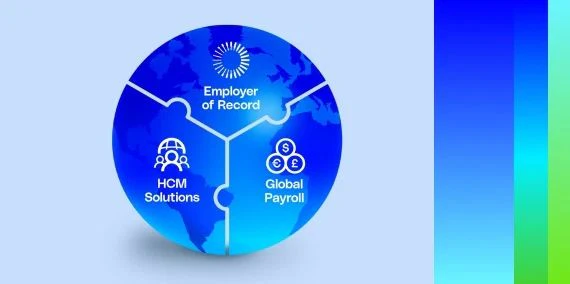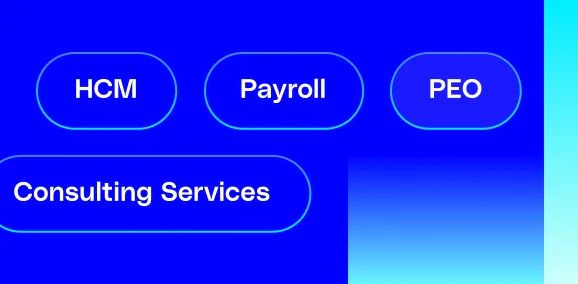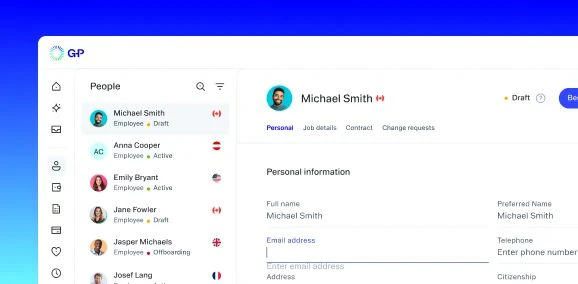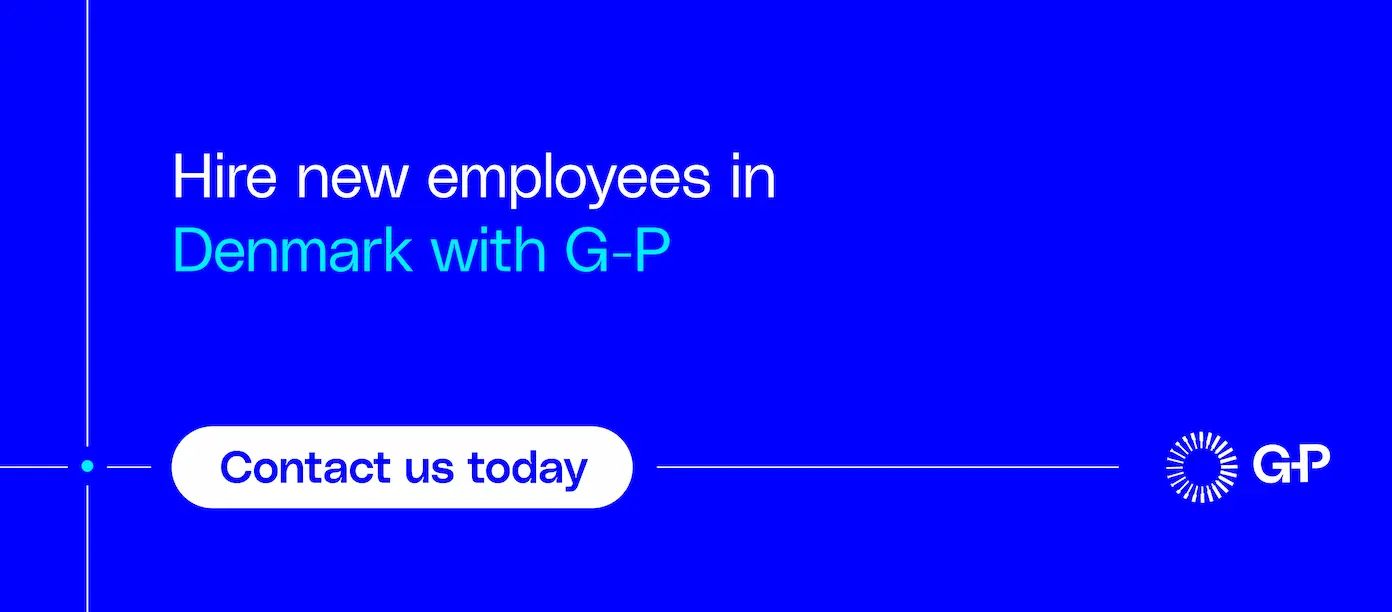Denmark is considered one of the happiest countries in the world. It’s also a great place to expand your company. The country ranks fourth in the world for ease of doing business — the highest among all European countries.
Before expanding into Denmark, you’ll need to understand contracts, taxes, wages, benefits, and other employment laws. Our guide will tell you everything you need to know about hiring in Denmark.
What to know before hiring in Denmark
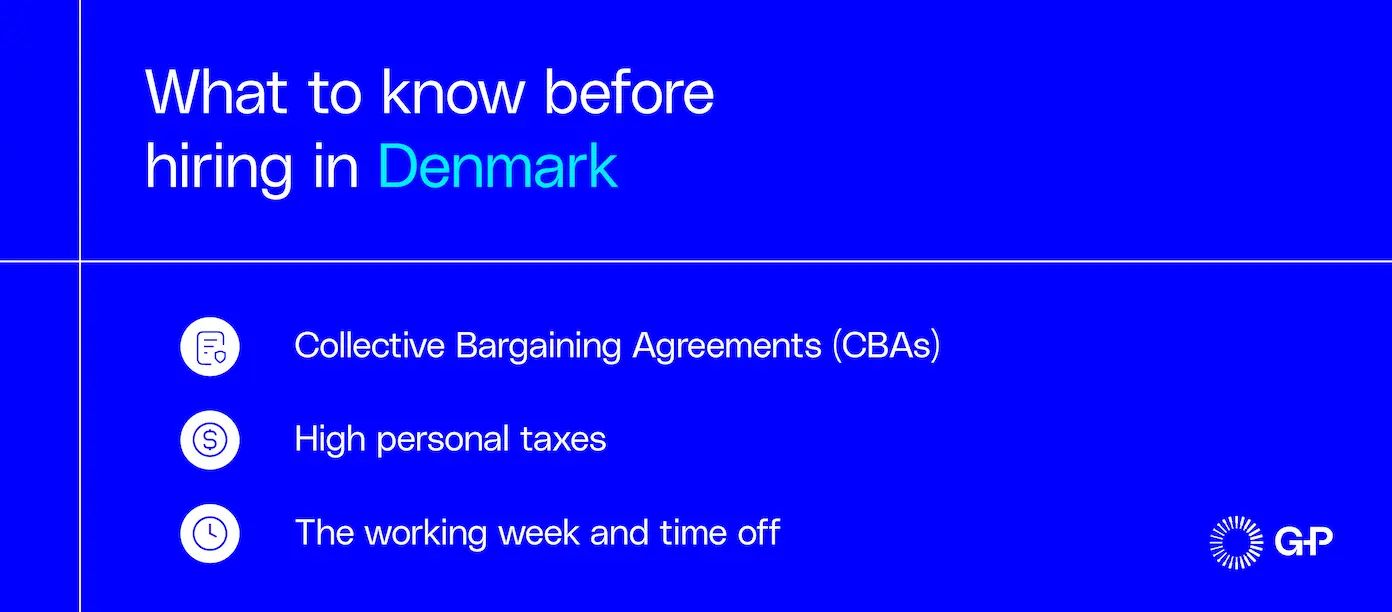
If you’re expanding your business into Denmark for the first time, there are important legal requirements to be aware of. These norms and laws influence hiring practices in Denmark and many aspects of the employer-employee relationship, including compensation and benefits.
G-P Gia™, our AI-powered global HR agent, can answer your toughest compliance questions across 50 countries — including Denmark — and all 50 U.S. states. Reduce your reliance on outside counsel and cut the time and cost of compliance by up to 95% with Gia.
Here are four things to know about hiring in Denmark.
1. Collective Bargaining Agreements (CBAs)
Roughly 74% of private-sector employees and nearly 100% of public sector employees are covered by Collective Bargaining Agreements (CBAs). CBAs set wages, working hours, overtime, holidays, notice periods, severance, and other employment conditions. CBAs differ from industry to industry. If you’re expanding to Denmark, check your sector’s applicable CBA.
2. The workweek and days off
The average workweek is 37 hours spread over five days. CBAs set this standard rather than statutory law. The EU Working Time Directive caps the maximum weekly working time at 48 hours, including overtime.
Employees get five weeks (25 working days) of paid leave. Holiday pay is 12.5% of the employee’s salary. Holiday pay is managed through FerieKonto or the applicable CBA. Denmark has several national holidays, such as New Year’s Day, Easter, and Christmas. The total number varies by region and sector.
Mothers get 18 weeks of maternity leave: four weeks before the birth and 14 weeks after. Fathers get two consecutive weeks of paternity leave. Paternity leave must be taken within the first 14 weeks of the child’s birth. Parents can share up to 32 weeks of parental leave.
Employees get full pay during illness. Employers cover the first 30 days (or as specified in the CBA). After the initial 30 days, the employee’s municipality covers sick pay. The maximum municipal sickness benefit as of 2025 is DKK 4,865 per week or DKK 131.49 per hour.
3. Taxes and social security
High personal and general taxes fund public services and the social security system. Employers in Denmark face a lower burden compared to other European countries. Workers with high incomes are taxed as much as 55%.
Employers have lower social security contributions. These cover:
-
ATP (labor market supplementary pension): A fixed monthly amount of DKK 189.35 (2025)
-
Occupational injury insurance: Rates depend on the industry
-
Other minor funds: Contributions for maternity leave, training, and holidays based on sector agreements
4. Employment contracts
Written employment contracts are legally required in Denmark. Employment contracts must outline the following:
-
Name and address of both employer and employee
-
Workplace location
-
Job title or description
-
Start date
-
Expected duration (for fixed-term contracts)
-
Policies for holidays and holiday pay
-
Terms of notice for employee and employer
-
Salary and pay frequency
-
Working hours
-
Information on applicable CBAs
G-P EOR has an Employment Contact Generator to help you draft compliant employment contracts that meet all legal needs and best practices in Denmark.
Top hiring hubs in Denmark
Some cities in Denmark are known for particular industries. Knowing what each city has to offer allows you to focus your hiring efforts in the right place and fill roles faster.
The top talent hubs in Denmark are:
-
Copenhagen is the capital and largest city. It's Denmark’s main economic and employment center. The city’s top industries include finance, technology, pharmaceuticals, life sciences, and shipping. Large companies like the Lego Group, Carlsberg, Maersk, and Trustpilot have headquarters or regional offices here.
-
Aarhus is Denmark’s second-largest city. It's a major hub for education, research, and technology. The city has a strong presence in IT, engineering, renewable energy, and logistics. It has a large student population from Aarhus University.
-
Aalborg is located in northern Denmark. The city has expertise in IT, telecommunications, and wind energy. Aalborg University contributes to its skilled workforce.
-
Esbjerg is Denmark’s main port on the North Sea. It’s the leading port for offshore wind power in Europe. The city is also a hub for the oil and gas sector, as well as shipping and logistics.
-
Odense is known for its robotics and automation industries. It’s a growing center for advanced manufacturing, technology, and healthcare innovation.
Key industries in Denmark
Understanding Denmark’s main industries allows you to benchmark salaries and benefits. You can use this insight to make smart choices about where to invest and grow your workforce.
The main industries in Denmark include:
-
Pharmaceuticals and life sciences: Denmark is a leader in pharmaceuticals, biotechnology, and medical devices. Successful companies like Novo Nordisk, Lundbeck, and Coloplast are headquartered in the country. Specialist talent includes R&D scientists, quality assurance and control professionals, and regulatory affairs professionals.
-
IT and digital services: The IT sector is strong in software development, fintech, cybersecurity, and digital innovation. Copenhagen and Aarhus are notable hubs. Specialist talent includes software developers, cybersecurity professionals, and data scientists and analytics specialists.
-
Renewable energy: Denmark is known for its leadership in onshore and offshore wind energy. Specialist talent includes various engineering roles, environmental and sustainability professionals, and grid and infrastructure professionals.
-
Manufacturing: The country is strong in advanced manufacturing, machinery, robotics, and industrial design. Specialist talent includes various engineering roles, technical specialists, and project managers.
-
Shipping and logistics: Denmark has a big maritime sector, including ports, logistics, and supply chain management. It's home to Maersk, one of the world’s largest shipping companies, which manages a fleet of over 700 vessels. Specialist talent includes logistics and supply chain professionals, transport planners and fleet managers, and warehouse operations professionals.
Cost of hiring in Denmark
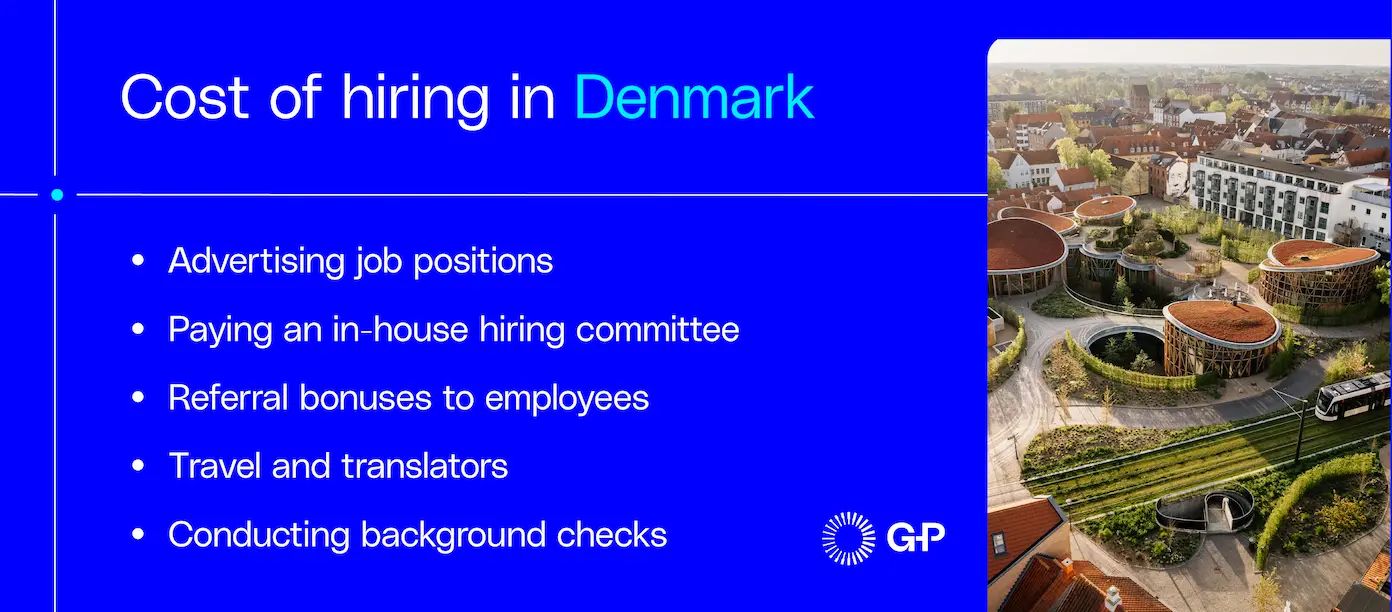
Whether you’re hiring one employee or an entire team in Denmark, expenses are inevitable. Budget for the following:
-
Setting up an entity (unless you partner with an employer of record)
-
Advertising job positions
-
Paying referral bonuses to employees with connections in Denmark
-
Paying an in-house hiring committee
-
Traveling to and from Denmark, including hotel stays, meals, and transportation
-
Partnering with a translator to write documents or facilitate conversations (if applicable)
-
Using a background check service for screening candidates
According to G-P Verified sources fromGia, the employer burden rate in Denmark, which includes costs triggered on top of salaries, is approximately 1–3% of gross salary, plus the fixed ATP and insurance premiums. This is lower than most countries due to Denmark’s tax-funded welfare model.
What does a company need to do to hire employees in Denmark?
Make sure you cover these essentials before expanding your team in Denmark:
-
Registering your company name with the Danish Business Authority (Erhvervsstyrelsen)
-
Getting a CVR and VAT number for all legal and tax purposes
-
Registering as an employer with the Danish Tax Agency (SKAT)
-
Registering for the ATP (labor market supplementary pension)
-
Setting up a compliant payroll system to handle salary payments, tax withholdings, and reporting
-
Taking out occupational injury insurance for all employees
-
Setting up a system for accruing and paying out holiday allowances
Establishing a Denmark subsidiary can take weeks or months. Use G-P EOR to hire full-time employees in Denmark without setting up your own entity. Build your team in Denmark at a lower cost and with peace of mind that you’re doing so compliantly.
Steps to hiring in the Denmark
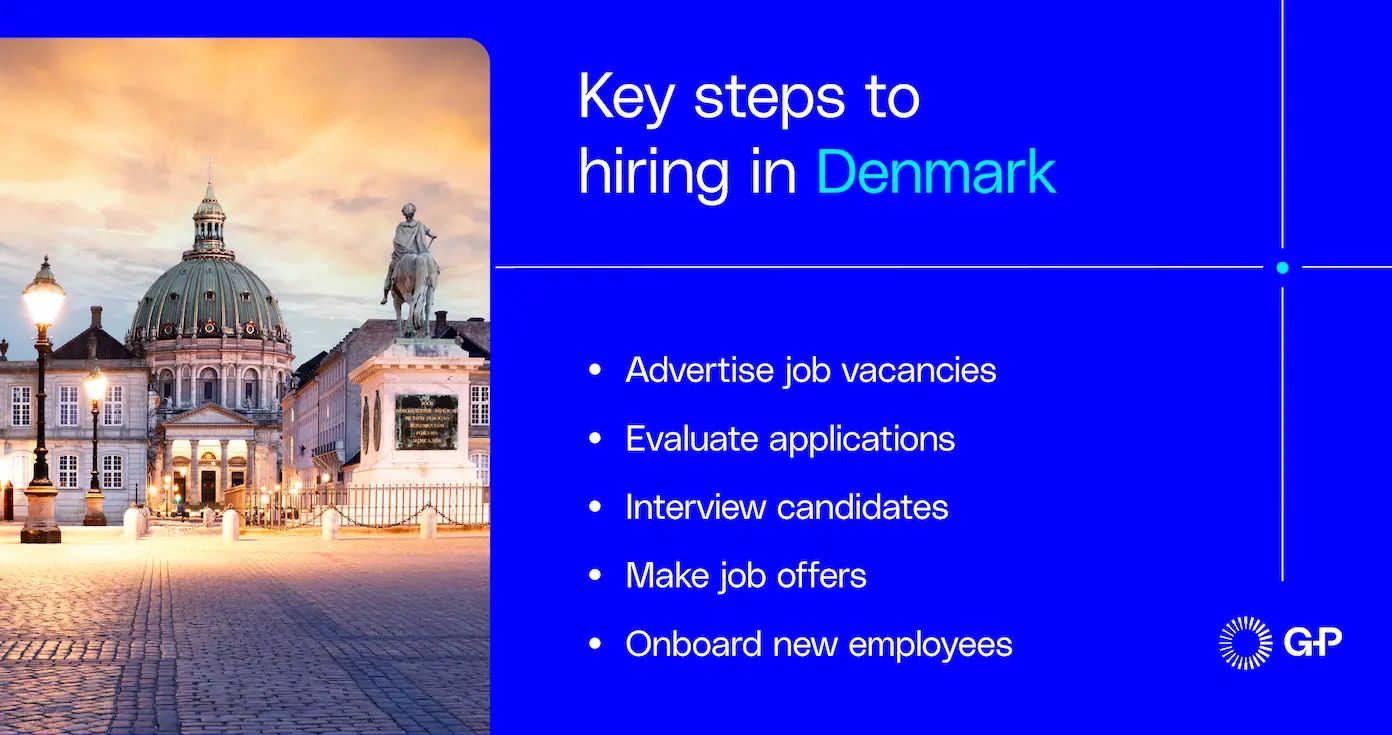
The hiring process in Denmark is similar to the one you’re likely familiar with in your own country. The hiring process follows five basic steps: advertising the job, evaluating applications, interviewing candidates, sending job offers, and onboarding new employees.
1. Advertise job vacancies
Create a detailed job description and define the role based on responsibilities and qualifications. Make sure job advertisements comply with antidiscrimination laws.
English is the recommended default language for job ads. If the role requires proficiency in a Scandinavian language or German, the ad can be in that language but must include an English summary and job title.
Post the job on relevant job platforms, such as Jobnet (the Danish public employment service).
2. Evaluate applications
Gather CVs and application forms. Screen candidates based on qualifications and experience, ensuring compliance with privacy and antidiscrimination regulations. It’s illegal to discriminate — directly or indirectly — on the basis of race, religion or belief, political opinion, sexual orientation, age, disability, or national, social, or ethnic origin.
Gia can answer all your questions about antidiscrimination laws in Denmark, so you can find the best fit for the role while complying with local regulations.
3. Interview candidates
Interview candidates who made it onto your shortlist. You can do these interviews in person or virtually. Use structured, nondiscriminatory interview questions.
Background checks are legal but strictly regulated under the General Data Protection Regulation (GDPR) and the Danish Data Protection Act. You must get explicit, written consent from candidates before conducting background checks.
4. Make job offers
Contact your chosen candidate to offer them a position with your company. Prepare a compliant employment contract. Include the job title, duties, salary, working hours, notice periods, and reference to any CBAs.
5. Onboard new employees
Now you can onboard new employees. You’ll have to register with the Danish Tax Agency and the ATP scheme. New employees need to be added to payroll for salary, tax, social contributions, and insurance premiums. Provide workplace safety training and make sure you’re compliant with the Danish Working Environment Act.
If you’re working with an EOR like G-P, you won’t have to worry about the administrative burden of onboarding. We’ll streamline the process, so you can focus on training your new hire and integrating them into your company culture.
Hiring contractors in Denmark
Working with independent contractors in Denmark can be a cost-effective way to test the market and build a presence, without the commitment of full-time employees. Contractors based in Denmark understand local consumer behavior, rules, and business practices. They’ll be ready to start working quickly with their own equipment and established work processes.
Hiring contractors allows you to easily adjust your workforce based on your business needs, without the complexities and costs of employment.
Before you enter an agreement with an independent contractor in Denmark, consider the following:
1. Employees vs. independent contractors
It’s important to understand the difference between employees and independent contractors. In Denmark, employers hire employees to do work and, in return, pay them a regular salary and benefits. Independent contractors provide services. Unlike employees, contractors set their schedules, use their own equipment, and work on specific projects rather than having an ongoing role.
2. Penalties for misclassification
Classifying someone as a contractor when they’re not can lead to severe penalties. If misclassification occurs, you’ll have to:
-
Pay all employment-related costs for the period of misclassification, including social security contributions.
-
Pay back all income tax withholdings, including interest and surcharges.
-
Face administrative fines for noncompliance with employment, tax, and social security laws.
3. How to pay contractors in Denmark
G-P Contractor™ takes away the messy, time-consuming process of hiring and paying international contractors. You can create and issue contracts and pay contractors with just a few clicks, all while ensuring a compliant process.
Hire employees and contractors in Denmark with G-P
Our SaaS and AI-powered products – EOR, Contractor, and Gia – support companies as they build and manage global teams.
G-P is the recognized leader in global employment with more than a decade of experience, the largest team of HR, legal, and compliance experts, and a global proprietary knowledge base.
Make your expansion to Denmark easier with G-P. Contact us or book a demo today.









